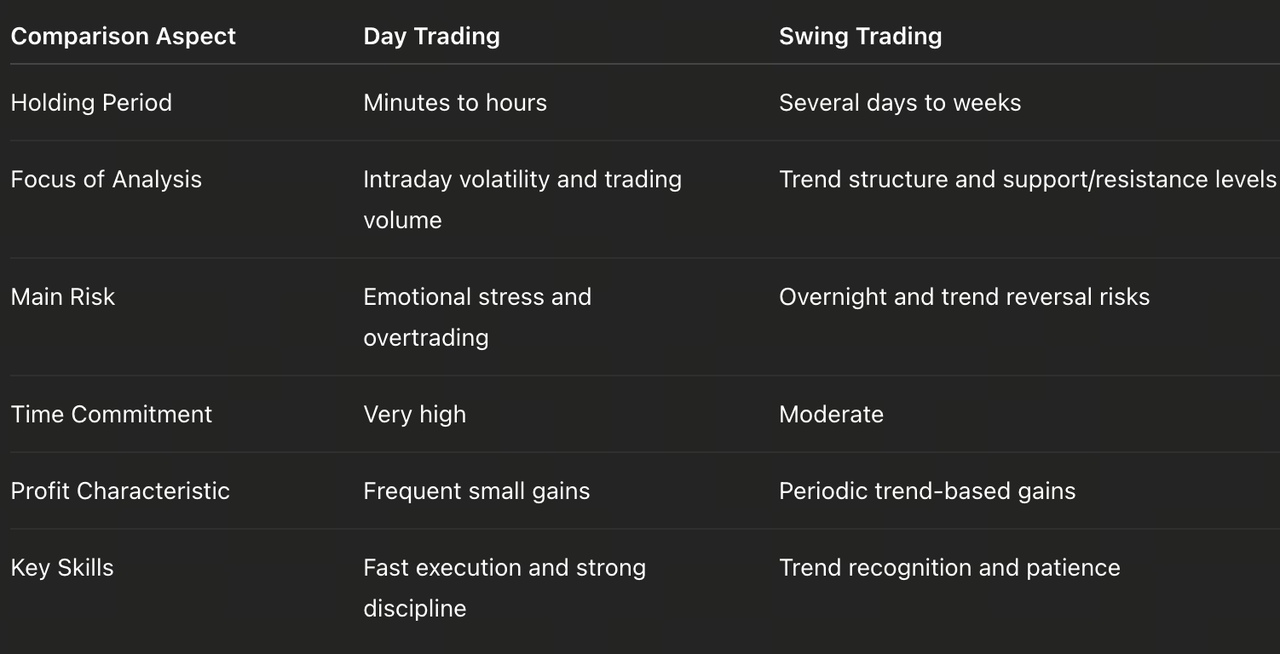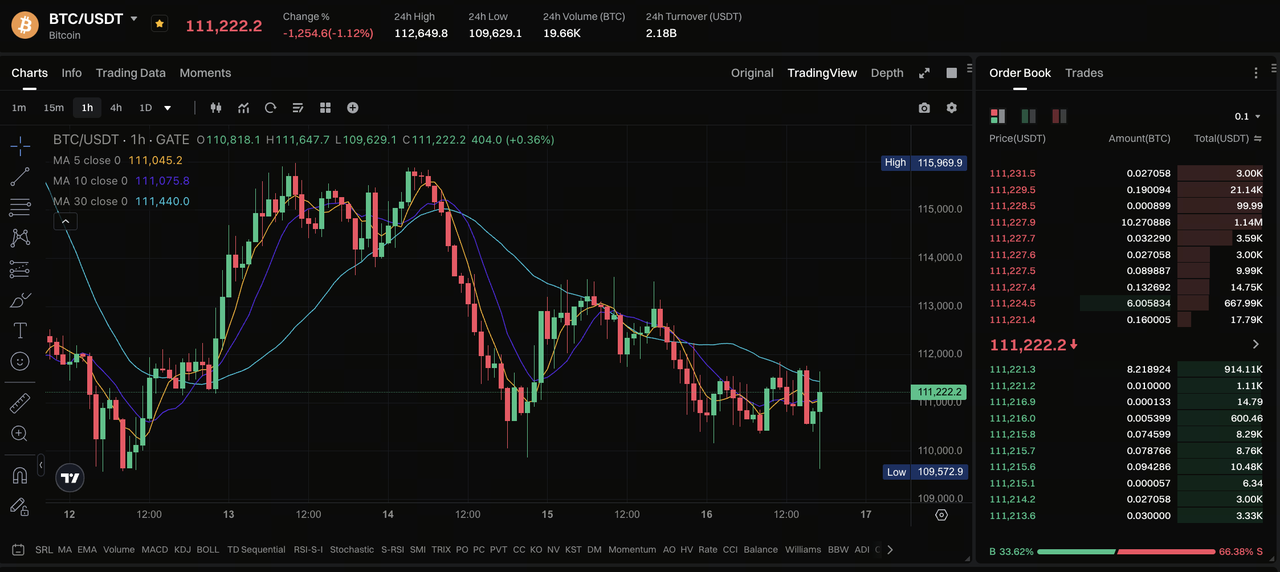Day Trading & Swing Trading
This course provides an in-depth analysis of the core principles and execution strategies of day trading and swing trading. Learners will understand the risk characteristics and return logic of different timeframes and develop their own active trading framework.
Understanding Active Trading Strategies
In the cryptocurrency market, investors generally fall into two categories:
- Active Traders: Profit from short-term market fluctuations.
- Passive Investors: Prefer long-term holding to capture trend-based gains.
This course focuses on the two most common strategies among active traders: Day Trading and Swing Trading.
Both rely on market volatility, but they differ significantly in terms of timeframe, analytical approach, and risk management.
Day Trading
1. Core Definition
Day trading refers to buying and selling assets within the same trading day, without holding positions overnight. This strategy emphasizes capturing short-term price movements and relies on high-frequency decision-making and strict discipline.
2. Strategy Logic
The essence of day trading is to “capture small fluctuations and accumulate gains over time.” Traders typically use technical indicators (such as RSI, MACD, or Bollinger Bands) or price patterns to determine entry and exit points. For example, when BTC breaks through a key support or resistance level, traders may execute multiple trades within minutes or hours.
3. Advantages and Challenges
Advantages:
- Positions are exposed to the market for a short period, effectively avoiding overnight volatility.
- Profit and loss are transparent, with results settled daily.
Challenges:
- Requires intense concentration and execution
- Higher trading fees and slippage costs
- Places significant emotional pressure may lead to overtrading
4. Suitable for
Traders who are highly sensitive to market movements, capable of making quick decisions, and willing to dedicate significant time to trading.
For beginners, however, without sufficient experience or discipline, frequent trading can easily amplify losses.
Swing Trading
- Core Definition: Swing trading typically involves holding positions for several days to a few weeks. Traders aim to profit from medium-term market swings by capturing a portion of a broader trend. Unlike day trading, swing trading focuses more on trend structure and market rhythm rather than short-term price fluctuations.
- Strategy Logic: The goal of swing trading is to take advantage of “a swing within a trend.” Common tools include technical indicators such as trendlines, moving averages, and Fibonacci retracements to identify key support and resistance zones.
For example, if ETH breaks through a major resistance level and then retests it as support, a swing trader may open a position during the pullback and hold it for several days to capture the next upward move.
1. Advantages and Challenges
Advantages:
- Lower trading frequency, reducing transaction costs
- More flexible time commitment, allowing trading alongside other work
- Easier to develop systematic strategies based on technical analysis
Challenges:
- Exposure to overnight risk—prices may be affected by sudden news.
- Requires patience and strong mid-term judgment.
Suitable for: Swing trading is more suitable for investors with some analytical skills who seek to balance risk with time commitment. It strikes a practical balance between the flexibility of short-term trading and the stability of long-term investing.
Core Differences Between Day Trading and Swing Trading

Risk Management and Trading Discipline
Regardless of the strategy used, risk management is the core condition for success. For day traders and swing traders, common disciplines include:
- Stop-loss settings: Determine the stop-loss level before entering each trade and execute it strictly once triggered.
- Position sizing: Limit a single position to no more than 5% of total account assets to prevent amplified losses.
- Backtesting and record keeping: Document the rationale, mindset, and outcome of each trade to identify effective patterns from historical data.
- Emotional control: Market volatility can trigger anxiety and greed. Staying calm and maintaining a consistent routine are key to long-term stability.
Case Study: Comparing BTC Day Trading and Swing Trading Operations

Source: https://www.gate.com/trade/BTC\_USDT
Take the BTC/USDT 1-hour candlestick on October 16, 2025 as an example, the current price is approximately 111,222 USDT, with a 24-hour range of 109,629–112,649 USDT, showing an overall sideways-down trend.
Day Trading Perspective
Trading Logic: Focus on capturing short-term price fluctuations, paying attention to moving average crossovers and 1-hour structure changes.
Current Signal: MA5 and MA10 remain below MA30, indicating short-term bearish dominance, but there are signs of a low-volume rebound at the bottom.
Trading Strategy:
○ Entry: Attempt to buy at near 111,000
○ Stop-loss: Below 110,000
○ Take-profit: Around 112,500
○ Trading cycle: Complete within a few hours
Key Mindset: React quickly, take profits promptly, and avoid overnight positions.
Swing Trading Perspective
Trading Logic: Follow mid-term trends, holding positions for several days while observing structural breakthroughs.
Current Signal: If the price breaks above and holds 112,800, a short-term rebound wave may form.
Trading Strategy:
○ Entry: Enter after BTC breaks above 112,800 and successfully tests it as support
○ Stop-loss: Below 110,500
○ Target Range: 115,000–116,000
○ Trading cycle: 2–4 days
Key Mindset: Be patient for trend confirmation; prioritize “trend range over trading frequency.”
Conclusion
Day trading and swing trading are two main active strategies in the crypto market.
The difference lies not only in timeframes but also in mindset:
• Day trading emphasizes speed and immediate decision-making.
• Swing trading emphasizes patience and trend judgment.
For beginners, it is recommended to start with swing trading to build a stable analytical framework and risk management awareness, then gradually transition to higher-frequency operations. The market always offers opportunities, but a stable system and discipline are key to long-term success. Under the current BTC structure, day trading is suitable for capturing rebound momentum, while swing traders should wait for trend reversal signals. The core difference between the two strategies lies in time horizon and mindset, rather than which is superior—the right strategy depends on matching your approach to market rhythm.





